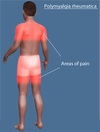CORText Flashcards
(736 cards)
Where do enchondromas occur?
Femur, humerus, tibia and small bones of hand/feet.
What is Reiter’s syndrome?
Triad of symptoms: urethritis, uveitis or conjunctivitis and arthritis.
Seen in reactive arthritis.
What treatment is best for mixed connective tissue disease?
Raynauds - calcium channel blockers.
If there is significant muscle or lung disease - immunosuppression.
What is an arthroplasty?
Removal of a diseased joint through excision or resection.
What is a Barlow test?
Dislocatable hip with flexion and posterior displacement.
How are undisplaced, minimally displaced and minimally angulated (stable) fractures managed?
Period of splintage or immobilisation.
Rehabilitation.
What is cauda equina syndrome?
Very large central disc prolapse compressing on all the nerve roots of the cauda equina - surgical emergency as the nerve roots involving defaecation and urination are affected.
Prolonged compression can cause permanent nerve damage requiring colostomy and urinary diversion.
What radiographic changes are seen in a late case of avascular necrosis?
Patchy sclerotic sclerosis of weight-bearing area of the femoral head.
Lytic zone underneath femoral head formed by granulation tissue from attempted repair.
What is the function of the lateral collateral ligament?
Resists varus force and abnormal external rotation of the tibia.
What are the red flags of back pain?
Neurological lower limb symptoms with bowel or bladder dysfunction.
Back pain in young patients (<20 years).
Sudden onset of NEW back pain in older patients (>60 years).
Nature of pain - constant, severe pain, worse at night.
Back pain with systemic symptoms of upset.
What is a large vessel vasculitis?
Primary vasculitis that causes granulomatous inflammation predominantly of the aorta and its major branches.
How is giant cell arteritis diagnosed?
Inflammatory markers (CRP, ESR or plasma viscosity) are almost always raised.
Temporal artery biopsy - mononuclear infiltration or granulomatous inflammation, usually with multinucleated giant cells.
What are the features suggestive of a benign soft tissue neoplasm?
Smaller size.
Fluctuation in size (malignant tumours don’t regress in size).
Cystic lesions.
Well-defined lesions.
Fluid-filled lesions.
Soft/fatty lesions.
What is carpal tunnel syndrome?
Swelling within the carpal tunnel resulting in median nerve compression.
What is the common organism that produces a late haematogenous prosthetic infection?
Staph. aureus.
Beta haemolytic strept.
Enterobacter.
What distribution of symptoms do cervical and lumbar nerve root compression give?
Dermatomal and myotomal distributions.
What are the upper limb compressive neuropathies?
Carpal tunnel syndrome.
Cubital tunnel syndrome.
What is the name of the radiographic sign associated with posterior dislocations of the humeral head?
The ‘lightbulb’ sign.
What loss of function are fractures of the distal radius that heal in a poor position (a malunion) may result in impaired grip strength associated with?
Loss of extension.
What is the action of infraspinatus?
External rotator.
What are the causes of cubital tunnel syndrome?
Tight band of Osborne’s fascia (fascia forming the roof of the tunnel).
Tightness at the intermuscular septum as the nerve passes through.
Tightness between the two heads at the origin of the flexor carpi ulnaris.
Where are the secondary lesions of osteosarcoma normally found?
Pulmonary mets.
Jaw, proximal humerus, proximal femur, mid-femur.
What is the management of proximal humeral fractures?
Minimally displace - conservative treatment with a sling and gradual return to mobilisation.
Displaced fractures - position often improves once muscle spasm settles.
Persistently displaced - internal fixation surgically, but stiffness, chronic pain and failure of fixation can occur particularly in the older patient.
Where does an acute intervertebral disc tear occur?
In the outer annulus fibrosis of an intervertebral disc.






























